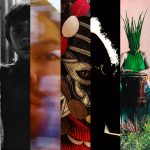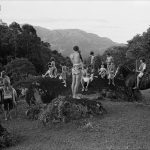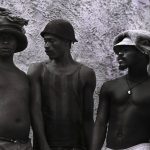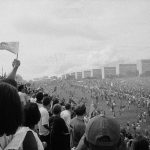Eyes of blood
Publicado em: 14 de January de 2020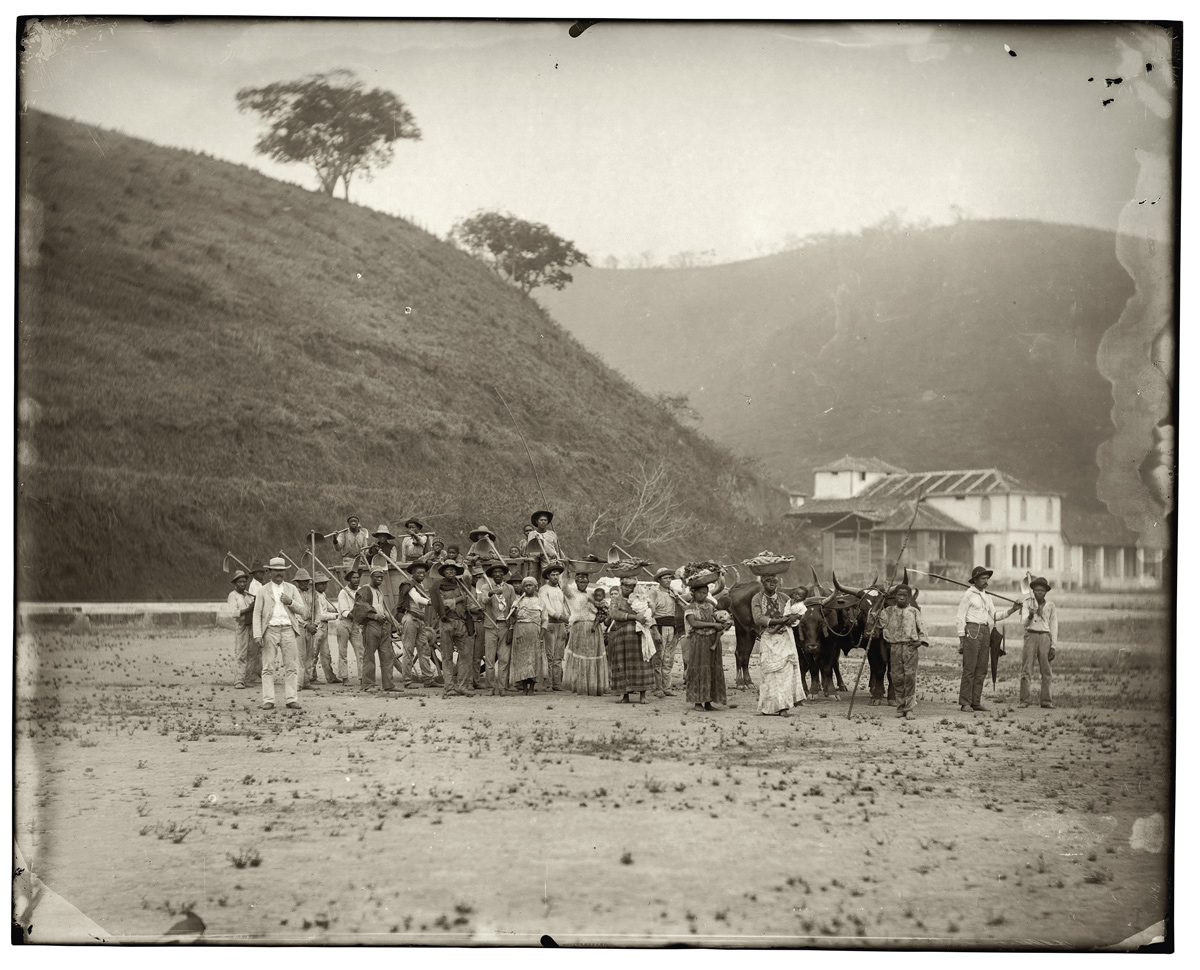
Partida para a colheita do café com carro de boi, vale do Paraíba, RJ, circa 1882 © Marc Ferrez / Coleção Gilberto Ferrez / Acervo Instituto Moreira Salles
The story of Marc Ferrez is intertwined with the history of photography in Brazil. Born in Rio de Janeiro in 1843, the son of a sculptor, Ferrez was orphaned when he was seven years old and went to live in France. When he returned to Brazil, he started working at the photographic studio Casa Leuzinger, the most prestigious stationer and lithographer in the Imperial capital. He rapidly became renowned in the craft of photography, taking part in a select group of photographers active at the time, including Alberto Henschel, Revert Henrique Klumb, Augusto Stahl, Vic- tor Frond and Georges Leuzinger. Ferrez opened his studio in 1867 and soon specialized, as informed in newspaper ads in 1872: “Marc Ferrez, 96 São José street. Specialist in Brazilian views.”
However, Ferrez produced an extensive volume of images, which included landscape and stereoscopic photographs, with artificial illumination, microphotography, and other formats. Among the photographer’s clients was the Emperor himself, ensuring a place for his works in the Brazilian imagination that perhaps no other 19th century photographer has conquered. Even now, his images are to be found in albums, publications, technical and scientific reports, postcards, and banknotes, remaining part of our collective unconscious.
The creation of images to promote a modern Brazil, underpinned by the model of coffee plantations, ensured work to various photographers at the time. Encouraged by the Emperor and taken at a time when competition for images of a socially orderly country in the throes of development was appreciated, these photographs soon came face to face with the slave-based economy that persisted throughout Brazil, an archaic system which isolated and prevented the country – the last Western one to abolish slavery – from becoming a member of the developed nations club.
This dual paradox – the modern being dependent on the archaic and the internal and permanent contradiction of a slave-based, monoculture system – is part of and produces a series of images done by Ferrez featuring enslaved subjects. These photographs are in contrast to the many images also taken by Ferrez exalting the coffee plantations, mining, and bridges, railroads and aqueducts under construction, in clear praise of “progress” in Brazil.
Just as there would have been no European modernity without the underdevelopment of the Europe’s colonies, says the Cameroonian philosopher Achille Mbembe, European humanism would not be built without the matching negation of the humanity status of those non-European. In the same way, but being cautious with the analogy, it would also not have been possible to stimulate the modernization of Brazil with- out the dehumanizing exploitation of slavery.
The modern and the archaic formed an articulated and structured unity of the country: behind the railroads, the new ports, the aesthetic refined rigor and visual beauty of the images, the technological development of new photographic machinery, was the archaic exploitation of slave labor. It cannot be forgotten that the people, who carried Ferrez’s scanning camera to the top of mountains so that he could take panoramic images of the city of Rio de Janeiro, were enslaved. The camera alone, which he had adapted from one imported from France, weighed around 110 kilos, not to mention the 8 kilos of each glass plate. The weight of slavery was, therefore, the sponsor of the supposed progress in Brazil, as well as photography itself, incisively impacting on the photographic creations of the period.
The photograph entitled Partida para a colheita do café com carro de boi [Setting off for the coffee harvest with an ox cart] was taken around 1882. The scene is made up of 35 men (the majority), women, children and babies lined up and carrying reapers, sticks, hoes and baskets. To the left of the group and a step nearer the viewer, the 36th figure adopts an air of command. He appears to be white and is wearing light-colored pants, a jacket and a hat, while his left hand grasps his lapel. He is wearing shoes, in contrast to the bare feet of the others, including those of the rare white figures, perhaps immigrants, in the middle of a predominantly black group. As is commonly known, unshod feet were a sign of the condition of captivity: slaves were not permitted to wear shoes, which they soon sought to acquire when they achieved freedom.
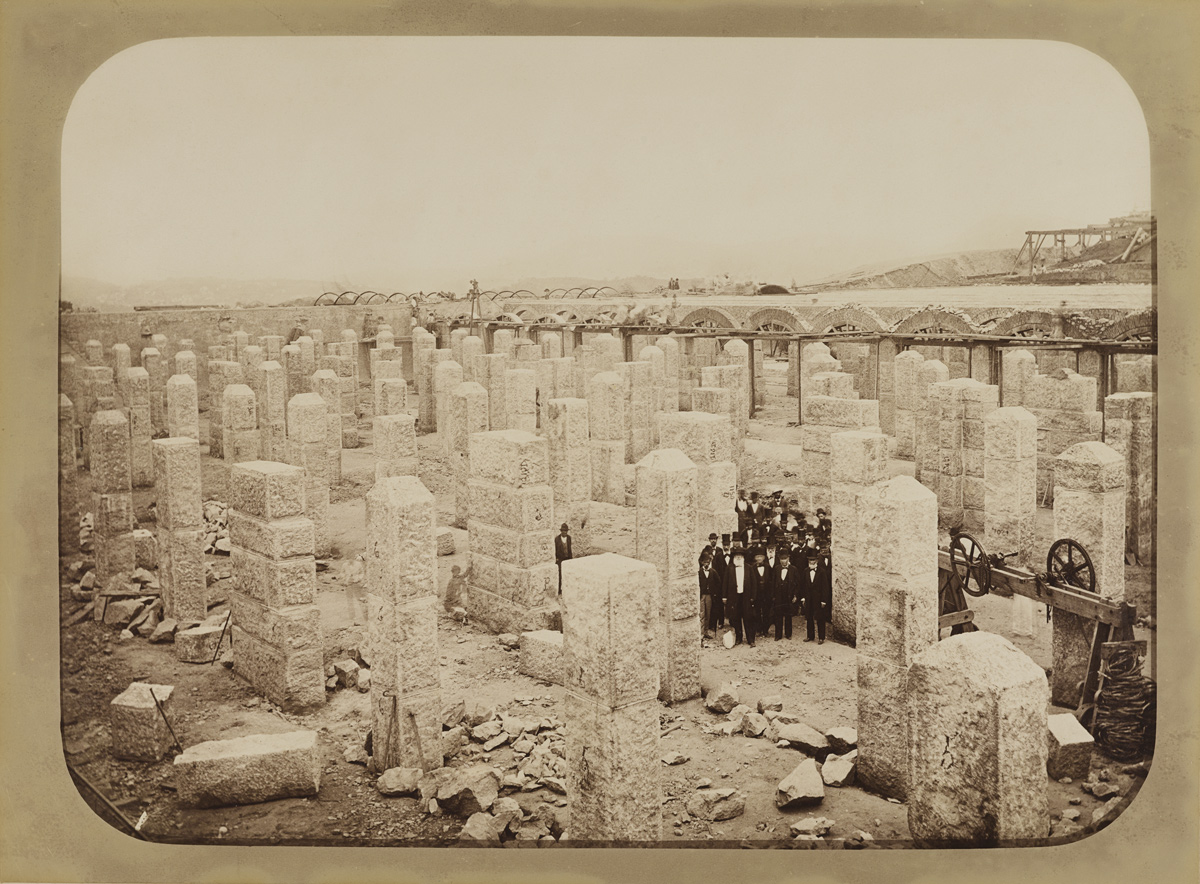
Visita do imperador d. Pedro II ao reservatório que leva seu nome, obras de abastecimento de água, Rio de Janeiro, RJ, 1879 © Marc Ferrez / Coleção Gilberto Ferrez / Acervo Instituto Moreira Salles
The women carrying babies in their arms are also carrying metal baskets on their heads, cloth bundles and umbrella handles, instead of sieves and straw baskets tied to their backs – the tools that those setting out to harvest coffee require, as the photo caption states.
The photograph is clearly staged. With the subjects in the mid-distance, and using a horizontal format, harmonized framing and a depth of focus that highlights the landscape, the image comes from the tradition of panoramic views, in which Ferrez specialized. The detailed placing of each individual in the scene also brings this photograph closer to the tradition of portraits of “human types,” standardized to show functions, activities, and generic rather than individual subjects.
The two men on the far right, separated from the main group, are good examples of the combination of conventions on which this image is based. One of them is white, shown in half-profile in a stiff pose. He is wearing a white kerchief around his neck over a shirt, which is also white. A metal chain is attached to his waist, perhaps belonging to a pocket watch, and he is carrying a spade over his left shoulder, an unexpected umbrella and a small machete hanging from his forearm. The other young man is black, and has a more relaxed posture, resting a shovel on his right shoulder as he stares at the camera. They both look as if they have been extracted from the stereotypes of “types of black people” for which Christiano Jr. was famous – a photographer specializing in studio images full of umbrellas, chairs, baskets and other strange scenic props, which effectively gave them an air of exoticism.
The photographer appears to have asked his subjects to look at the camera, but the enlarged image allows us to see that some of them ignored the order. In the fine detail, we can observe more of the aspects that probably escaped the control of Ferrez: the expressions on the faces of the enslaved, some of them distrustful, annoyed or distracted; a baby clutching its mother, pulling on her blouse; another sucking its finger; the woman who tilts her neck to better support the head of her baby; a child leaning its chin on the ox cart with an air of innocence, oblivious to the scene. To the right, the back of a two-storey house with white walls and arched windows looms: the casa-grande [the farmer’s house], a symbol of vigilance and opulence, marking the division between the sky and the earth in the composition.
The people are grouped in the lower half of the frame, on a stretch of rammed earth. In the upper part, the hills covered in scrub, the trees, the sky and the mist provide a counterpoint between the high and the low, between an idyllic landscape and a place of forced labor, between aspects of nature and of the human culture. The mist in the background gives a dreamlike feeling to the scene. This is the theatrical scenery of slavery, in which the aesthetic approach to colonial relations of subjugation and control gains an aspect of artificial beauty. Everything is in order; everything is in its proper place.
At the time when this photograph was taken, the Paraíba Valley [between the cities of Rio de Janeiro and São Paulo] had the largest concentration of slave labor in the whole Empire. Ferrez’s photographs, which generally date from 1873 onward, were taken in the decade before the legal abolition of slavery and the proclamation of the Republic. They give no indication of the turbulent times in which they were taken, when quilombos [rural settlements founded by runaway slaves] sprang up in increasing numbers, and the number of slaves escaping individually or in groups, the burning down of mills, revolts and the activities of abolitionist movements throughout the country were also multiplying.
In the middle of the slavery crisis, Ferrez produced a set of images without any sign of fetters, conflict or resistance. What appears in the images is a sanitized, orderly, romanticized slavery. The descriptions of runaways in newspaper announcements, the travelers’ tales, and the documents dating from the period are full of the marks of violence and abuse on the bodies of the enslaved – scars, brands and marks left by iron and whipping, the use of gags and tinplate masks, burns and amputated limbs – but Ferrez’s photographs are calm. They would be beautiful if they were not charged with such implied violence.
This photograph plays tribute to a series of images of slaves lined up, taken by Frond twenty years before Ferrez, such as Partida para a roça [Leaving for the farm] (1861). The similarity is not by chance; in fact, he emphasizes like the photographer when building this composition, using as reference earlier images, which served as both guide and model for him. There are various aspects of the conventions of the time for photographs of slaves: representation in groups and in an external environment, without domesticity and in work situations; the emphasis given to the owners or overseers; the rare presence of white ladies; the depersonalization of those depicted, reduced to image and form, exteriority and physiognomy. Instead of the person, the character; in place of the singular, the generic; in place of I, them.
The enslaved ones who appear in these images are not people as such, but types: even if their faces are evident, their individuality is suppressed in favor of a whole that they supposedly represent. We know hardly anything of them: their name or surname, age, relationship, wishes or dreams. “We know that they are slaves from their unshod feet. But also by the way they are portrayed. In a portrait, you can see and be seen,” wrote the anthropologist Manuela Carneiro da Cunha about the photos by Christiano Jr. “Anyone who orders a photograph displays themselves, makes themselves known, spreads themselves through the paper, not only themselves but their attributes and properties, how they would like to be seen, how they see themselves in the mirror. They are the subject of the portrait. Here the slave is to be seen, they don’t display themselves. And they are seen in ways that depersonalize them.” A reflection which could be extended to this photograph by Ferrez.
Photos of the enslaved and the original peoples of Brazil and Latin America attest to an intentional and repeated trend towards the literary or pictorial interpretation of local, everyday life, which discards the possibility of coincidence. The methods of recording are varied; there remains, however, the adventitious look that reduces the portrayed to objects. Only the few who were free or freed, and who succeeded in accumulating some capital, could order photographs of themselves. Rare portraits of black people of the time provide evidence of a certain degree of negotiation between the portrayed and the portrayer about the way they were to be photographed.
Selection and cropping are always to be found in photographic records: they not only register an image, but recreate, induce; they reside on the frontier between truth and invention, between the documentary and the creative. We know that images create discourse, that they are discourse. Ferrez’s photographs in the Paraíba Valley give visuality to a type of rhetoric that meets the interests of the coffee growers. They are not neutral, visual documents, objective witnesses to their time.
These images were widely accepted and circulated amongst the Brazilian slave owners of the time, pleasing the Emperor and the coffee growers. The honors and commissions that Ferrez received during his life prove this: he was, for example, Photographer to the Imperial Navy, to the Imperial Geological Commission, to the Dom Pedro II Railroad and the Corcovado Railroad; he received the title of Knight of the Order of the Rose from the Emperor, and the silver medal at the Paris Universal Exhibition, while his photographs were published in the Álbum de vistas do Brasil [Album of views of Brazil].
We can only understand the complexity of the images taken by Ferrez through the power relations that define whose interests the photographs served, who its object was and the asymmetries that built an invisible but effective barrier between the photographer and those he photographed.
Partida para a colheita do café com carro de boi is an image of calm, orderly, and peaceful slavery, naturalized as a common and natural element in the Brazilian social territory, a necessary part of the nation’s progress. It is also an image that reinforces the iconography that forms the country, which repeats the representation of black bodies in a situation of slavery, banalizing it before our eyes. An image that is symptomatic of the contradictions of a country founded on the language of violence, the effects of which are still evident today, despite the passage of time.
Hence the urgent need to critically understand photographs like this, decolonizing the way we look at them. “Vision is always a question of the power to see – and perhaps of the violence implicit in our visualizing practices,” states the American philosopher Donna Haraway, whose question reverberates as an ethical reminder of what one can no longer avoid: “With whose blood were my eyes crafted?” ///
© marc ferrez/gilberto ferrez collection/instituto moreira salles collection
+ Marc Ferrez Collection: ferrez.ims.com.br
+ “Situated Knowledges:The Science Question in Feminism and the Privilege of Partial Perspective”, by Donna Haraway, in Cadernos Pagu #5 (Situando diferenças, 1995)
+ “Olhar escravo, ser olhado”, by Manuela Carneiro da Cunha, in Escravos brasileiros do século XIX na fotografia de Christiano Junior (Ex Libris, 1988)
+ Critique de la raison nègre, by Achille Mbembe (English edition: Critique of Black Reason, 2017. Duke University Press)
+ Catalog Marc Ferrez: Territory and Image (IMS, 2019)
+ Marc Ferrez, uma cronologia da vida e da obra, by Ileana Pradilla Cerom (IMS, 2019)
MARC FERREZ (Rio de Janeiro, 1843-1923) is one of the main Brazilian photographers from the 19th century. He worked during the Empire and the first decades of the Republic.
HÉLIO MENEZES is an anthropologist, art critic and curator at the Centro Cultural São Paulo. He jointly curated the exhibition Histórias afro-atlânticas [Afro-Atlantic histories] (2018) in MASP and in the Instituto Tomie Ohtake, São Paulo.
Tags: Brasil colonial, Brasil imperial, escravidão

